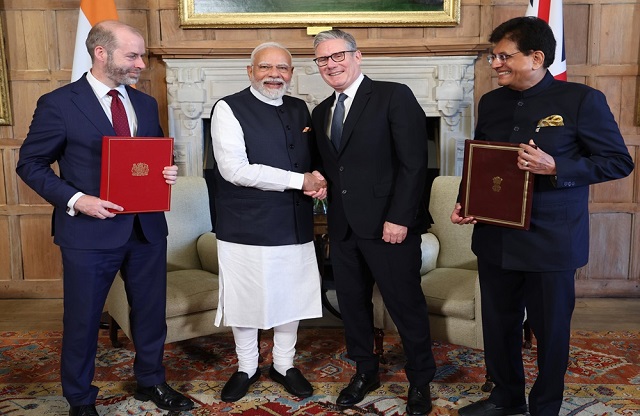By Hadia Noor
On 24 July 2025, India and the United Kingdom finalized a historic Free Trade Agreement (FTA) that eliminated tariffs on 99% of Indian exports to the UK—including garments, fabrics, leather goods, and accessories. This deal is being called a game-changer in global apparel sourcing, and it comes with ripple effects for neighboring Bangladesh—currently one of the UK’s top apparel suppliers.
As duty barriers fall for India, it reshapes sourcing dynamics for fashion retailers across the UK. Let’s unpack what this means for both India and Bangladesh, in terms of market access, challenges, and opportunities.
India’s Gaining Ground: Numbers, Access, and Momentum
India’s textile and apparel industry is experiencing renewed energy. In FY 2024–25, India’s total textile and apparel exports reached USD 37.9 billion, with USD 1.4 billion going to the UK—making up approximately 6.6% of UK’s textile imports.
With the new FTA, these goods now enter the UK market completely duty-free, eliminating earlier tariffs of up to 12%. This is particularly impactful for SMEs, which previously found it difficult to compete with suppliers from Bangladesh, Vietnam, and other LDCs enjoying preferential trade terms.
The Indian government estimates that UK-bound textile and apparel exports will double to USD 2.8–3.0 billion by 2026–27, with an annual growth projection of around 11–13%.
Also Read: Bangladesh Garment Exports at Risk as Chittagong Port Strike Freezes Trade
The FTA not only benefits Indian exporters but also enhances UK brands’ access to the Indian market, easing entry for luxury, high street, and lifestyle brands across sectors—from clothing and accessories to cosmetics.
Bangladesh’s Stronghold: Present Advantage, Future Uncertainty
Bangladesh remains a dominant force in UK fashion sourcing. In 2024, it exported USD 4.17 billion worth of RMG (Ready-Made Garments) to the UK, accounting for roughly 20% of the UK’s apparel imports. This makes Bangladesh the second-largest apparel supplier to the UK after China.
Currently, Bangladesh benefits from duty-free access under the UK’s Developing Countries Trading Scheme (DCTS)—a benefit expected to continue until at least 2029 due to its LDC status. However, this window is closing. As Bangladesh prepares for LDC graduation, there’s a looming threat of losing these tariff advantages unless a bilateral Economic Partnership Agreement (EPA) is signed with the UK.
Even as Bangladesh holds the upper hand in volume-based, price-sensitive segments—such as basic knitwear, denim, woven shirts, and value fashion—it faces growing pressure to innovate. India’s pricing parity now challenges Bangladesh’s historical edge in the UK market.
Common Challenges: The Race to Stay Competitive
While India celebrates the FTA, challenges remain. The country must ensure:
- Scalable production to meet UK demand
- Improved turnaround times and logistics
- Enhanced compliance, sustainability, and labor standards to satisfy increasingly conscious UK buyers
- India’s lack of vertical integration in man-made fiber (MMF) production could also limit some opportunities—unless investment flows increase rapidly.
Bangladesh, on the other hand, needs to:
- Secure post-2029 duty-free access
- Shift from basic goods to more value-added, diversified products (e.g., outerwear, lingerie, sportswear)
- Invest in green manufacturing, digital compliance, and traceability, areas where it already holds a leading reputation
The UK market is evolving fast—with rising demands for sustainable, traceable, and digitally transparent sourcing. Both India and Bangladesh will have to adjust not just on pricing, but also on speed, service, and supply chain integrity.
The Road Ahead: Risks for One, Opportunity for Another?
This FTA has set India on a fast track to expand its UK presence. For Indian exporters, this is an open door to a massive market where pricing matters—and the removal of tariffs suddenly puts them on equal footing with Bangladesh.
Also Read: Bangladesh’s RMG Exports to EU Surge 24% in First Four Months of 2025
For Bangladesh, it is both a wake-up call and an opportunity. Its current dominance is secure, but its future will depend on how it adapts to a post-LDC reality. Policymakers must act swiftly to negotiate trade continuity, while the private sector must move toward product innovation and value-added growth.
Interestingly, both countries can also explore complementary strengths in a regionally integrated supply chain—where India provides innovation and MMF capabilities, and Bangladesh offers cost-efficient large-scale manufacturing.
In Summery
The India–UK FTA is not just a trade deal—it is a shift in the global sourcing landscape. While India unlocks a long-awaited gateway to the UK fashion market, Bangladesh must now act strategically to hold its ground. The next five years will define how each country adapts, competes, and collaborates in a fashion industry that’s undergoing rapid change.






